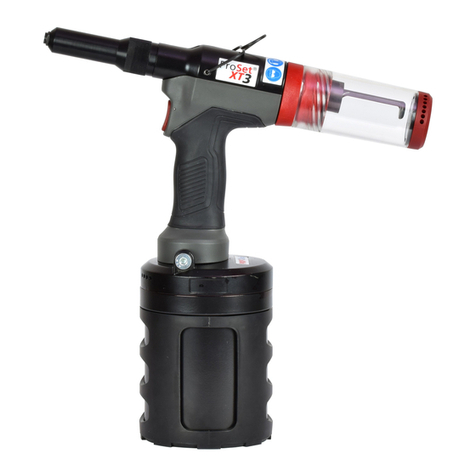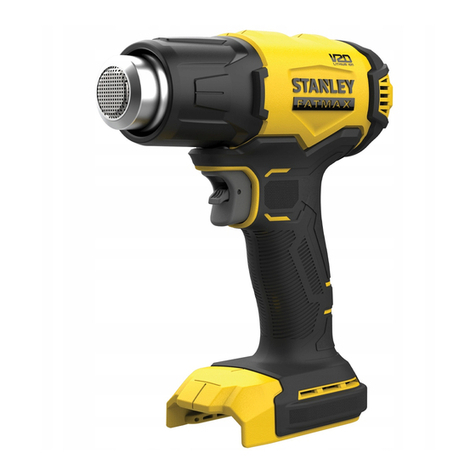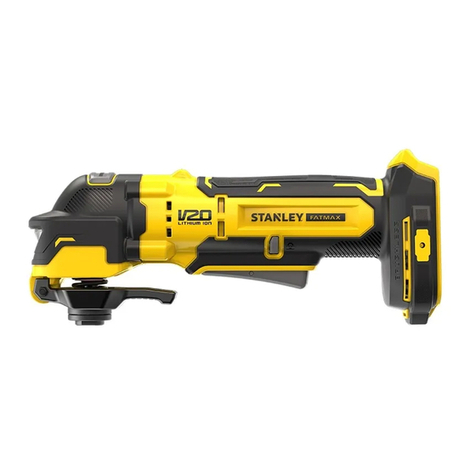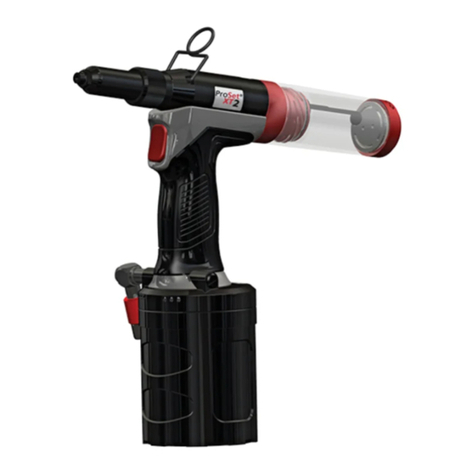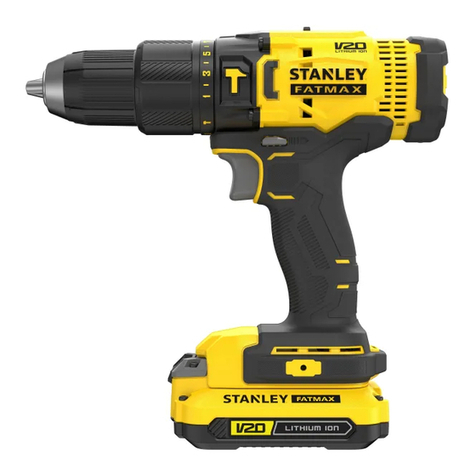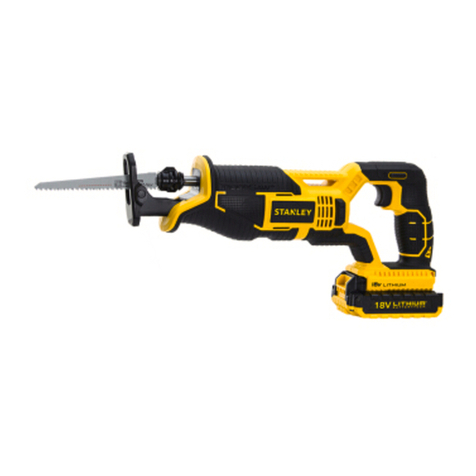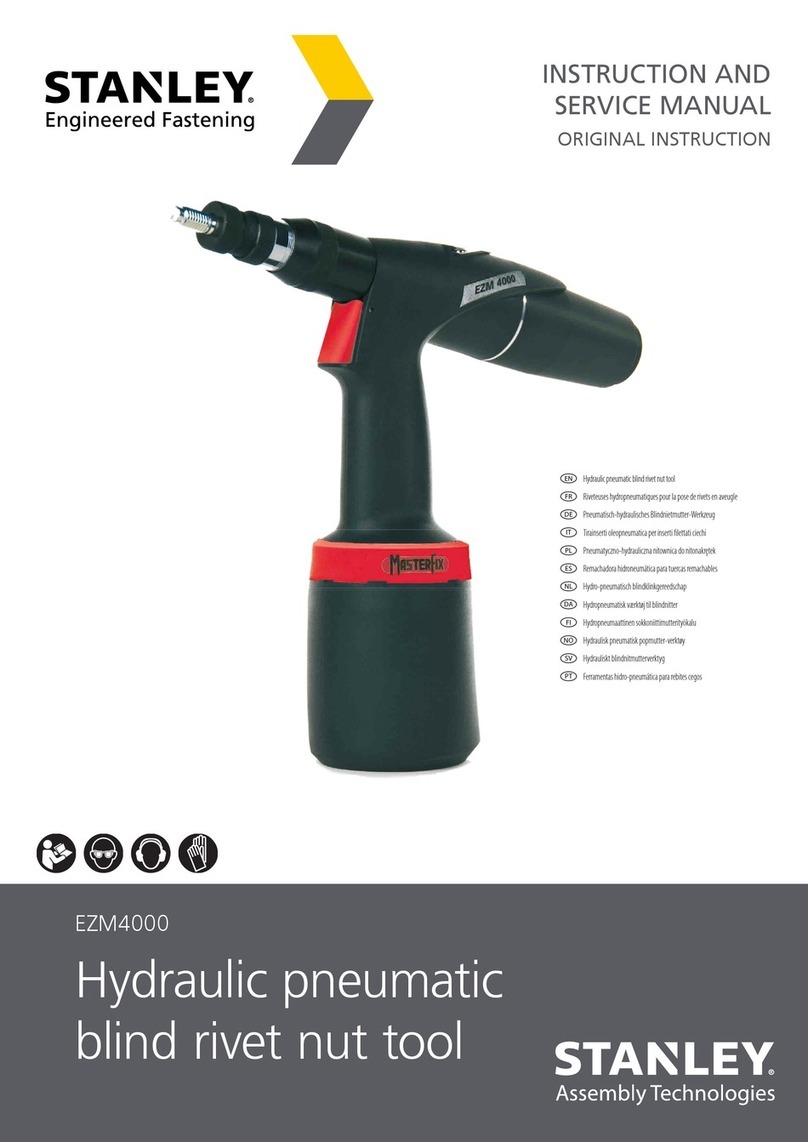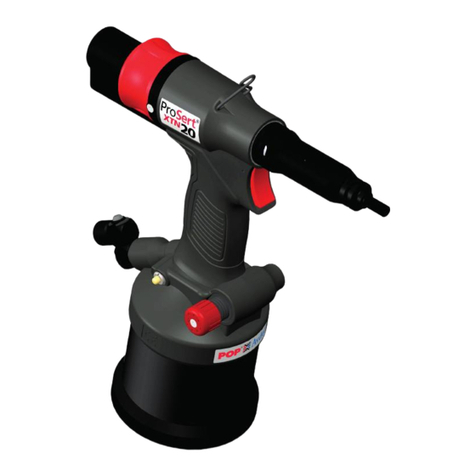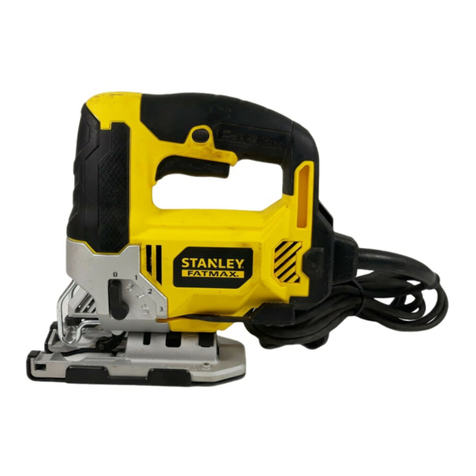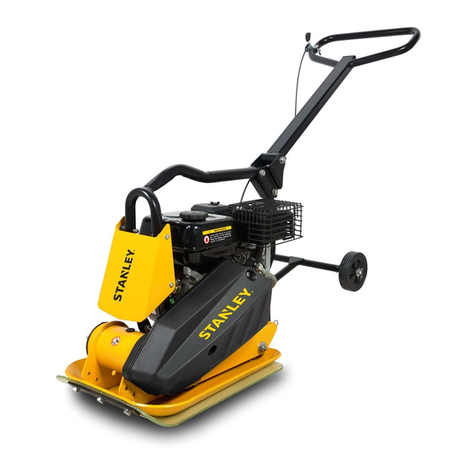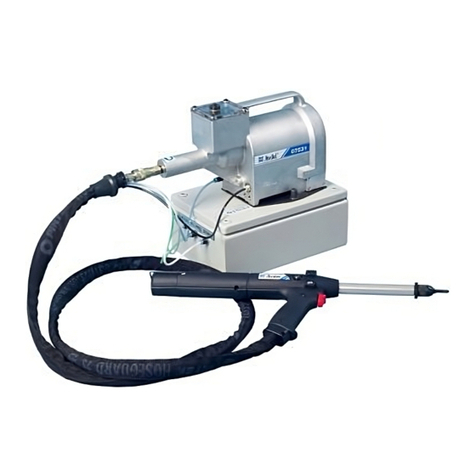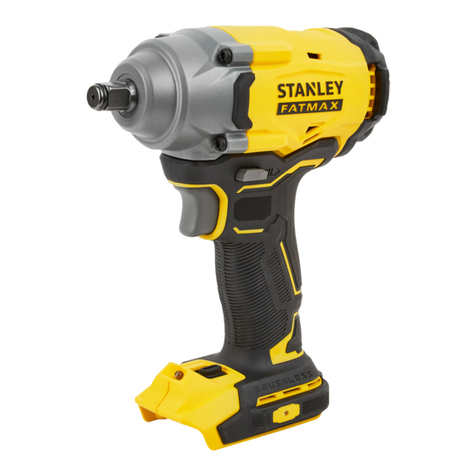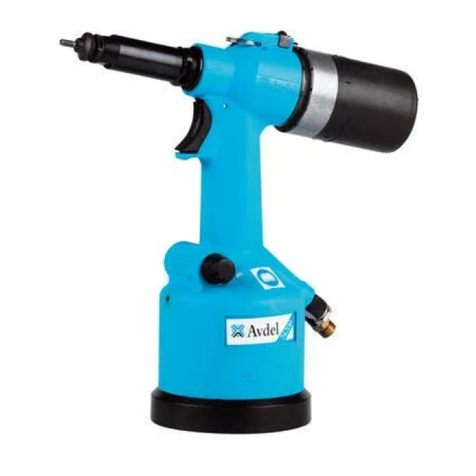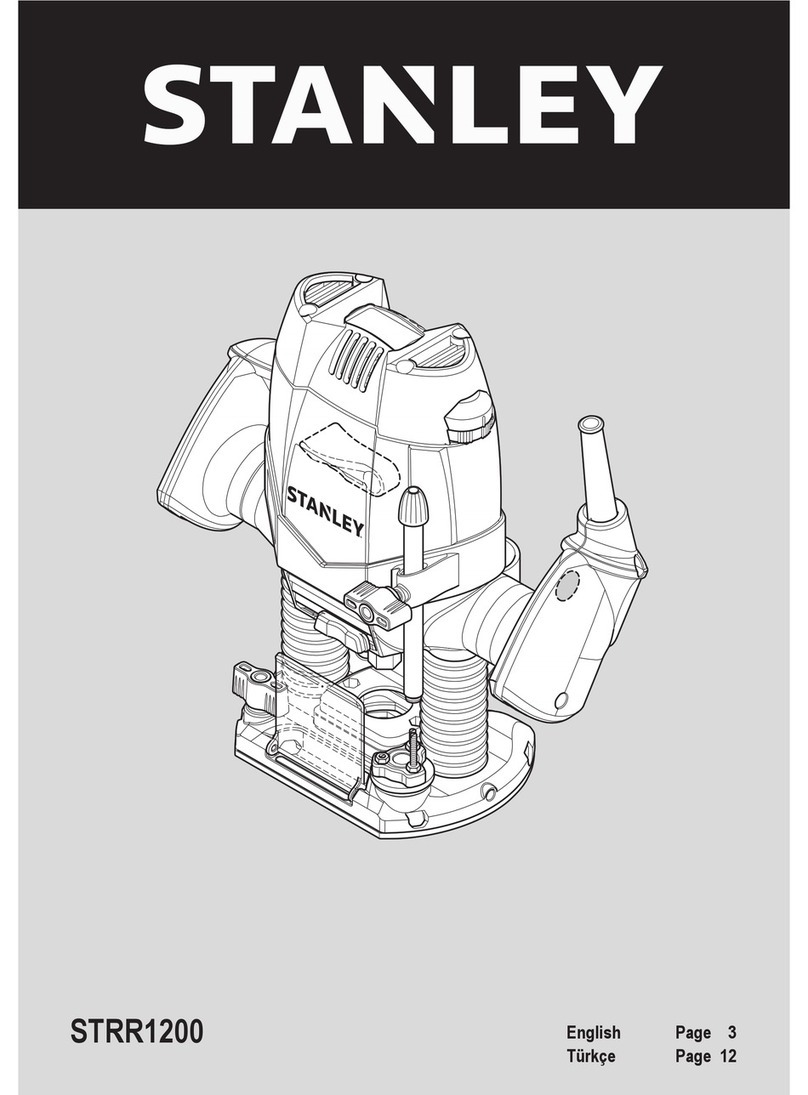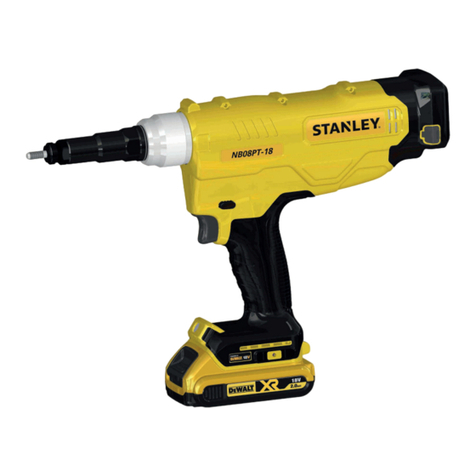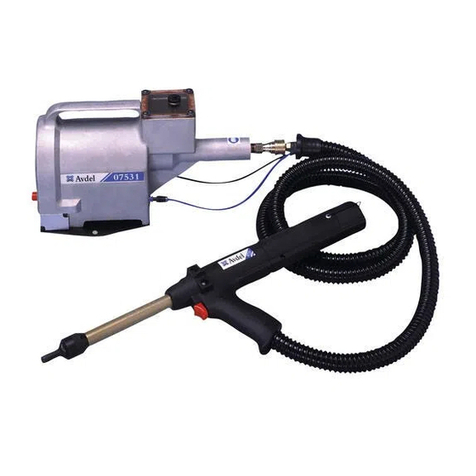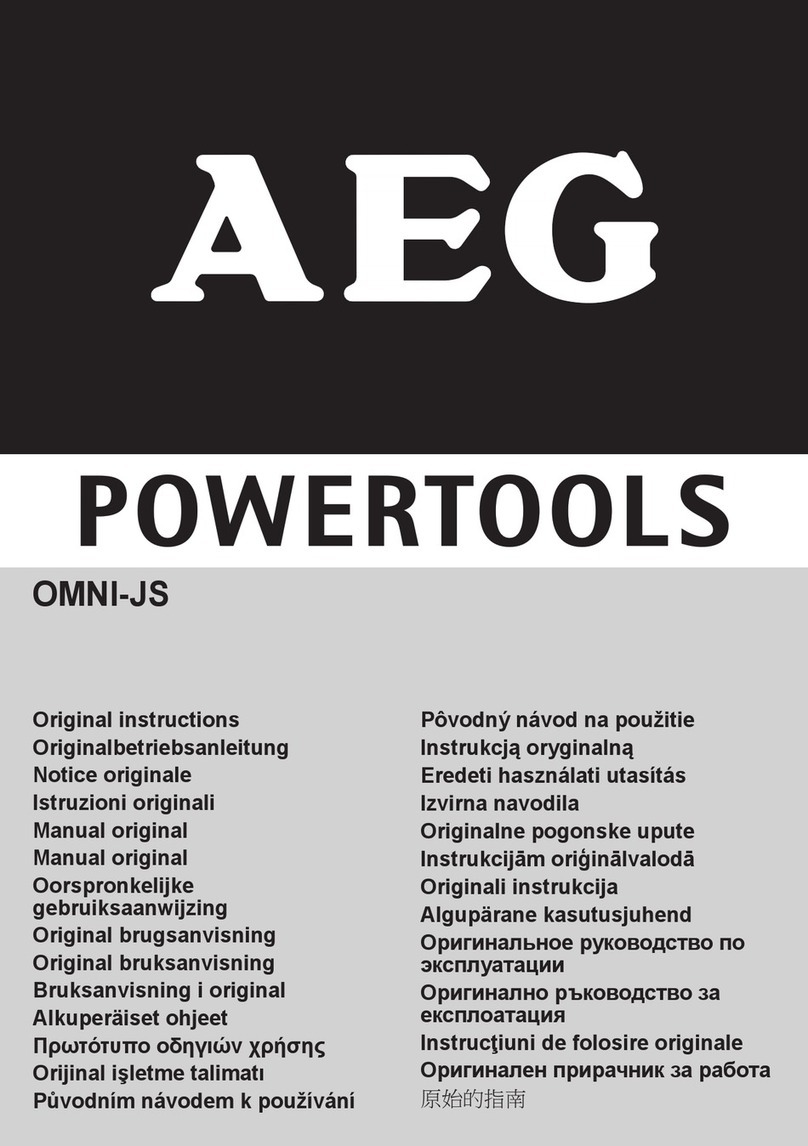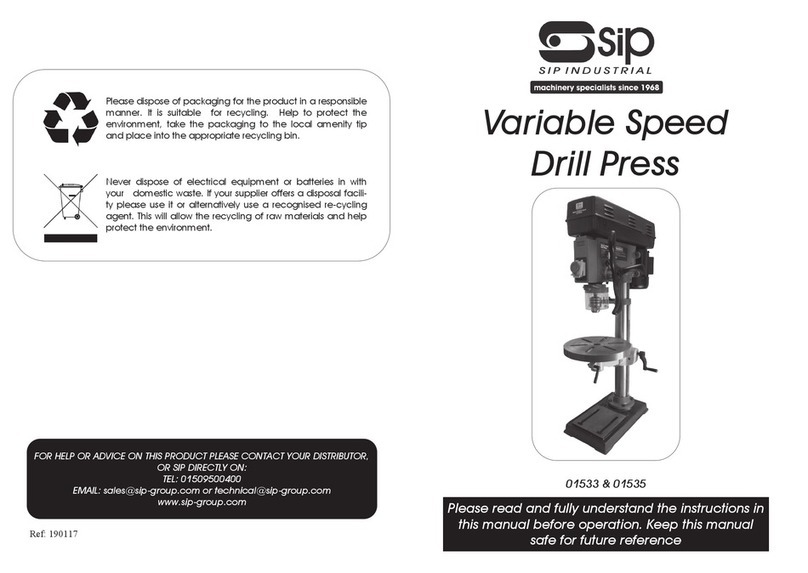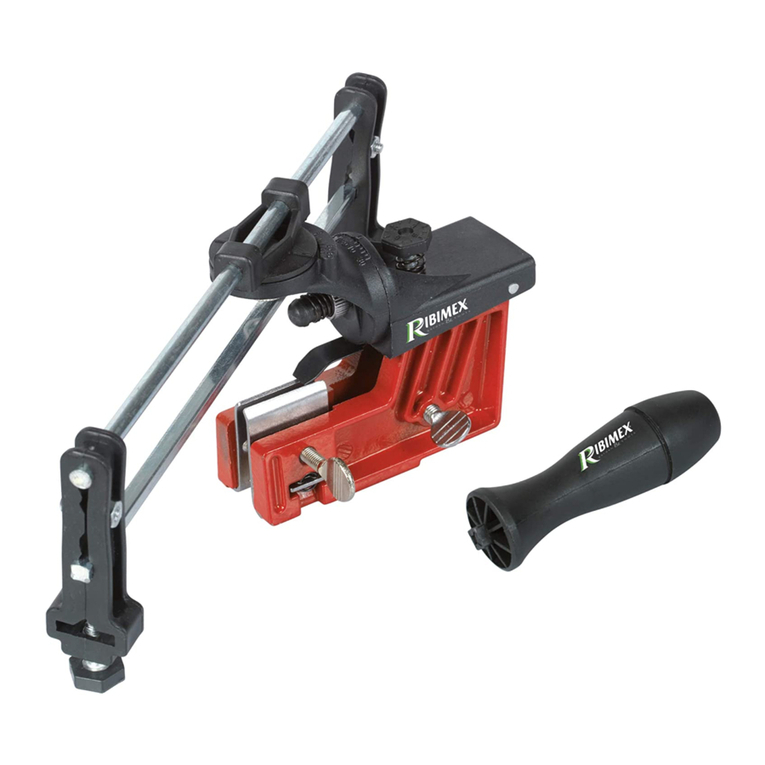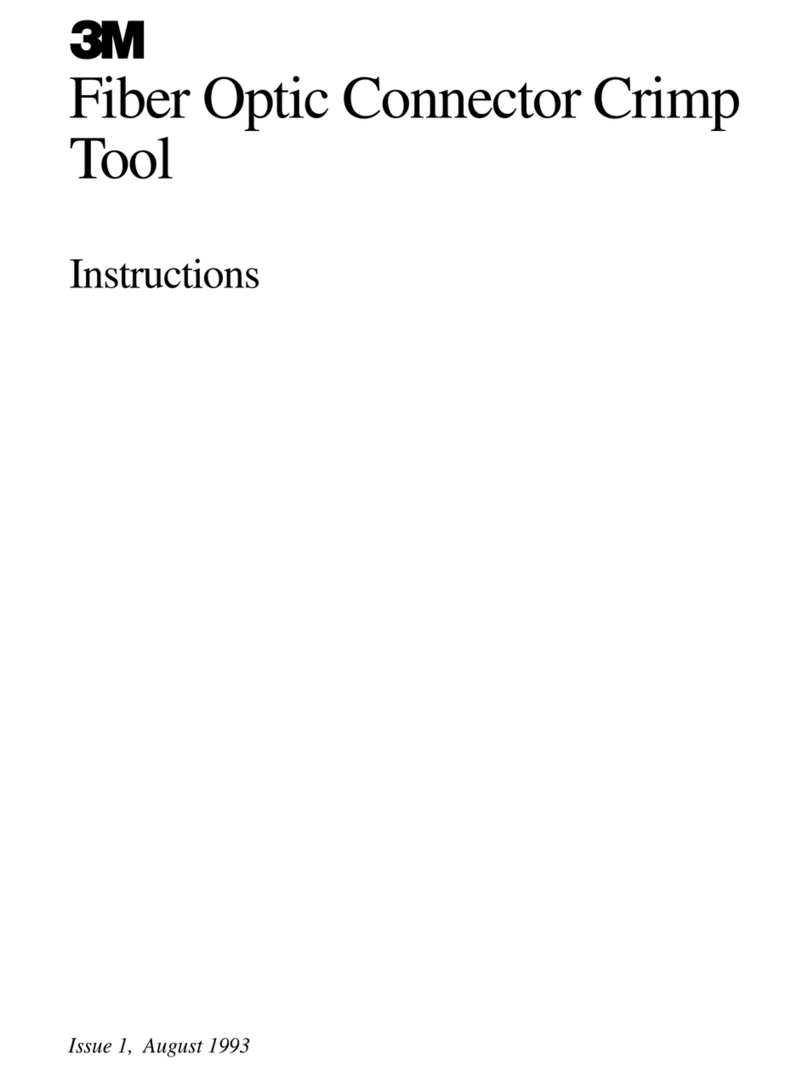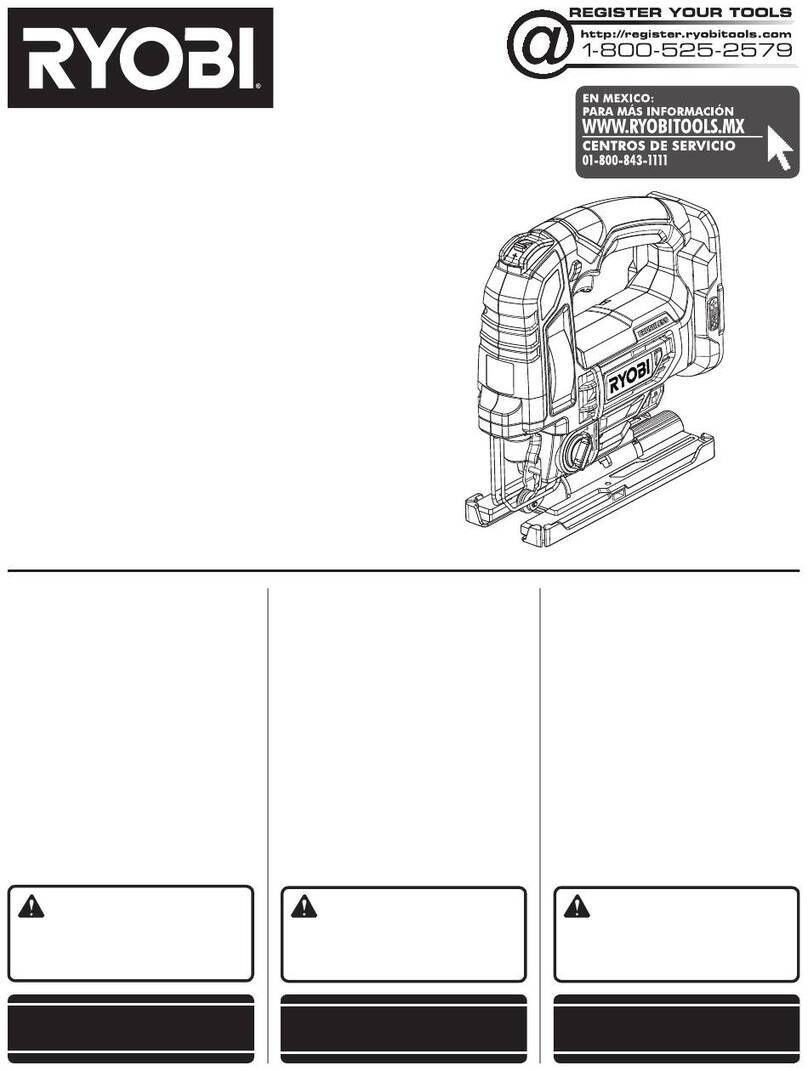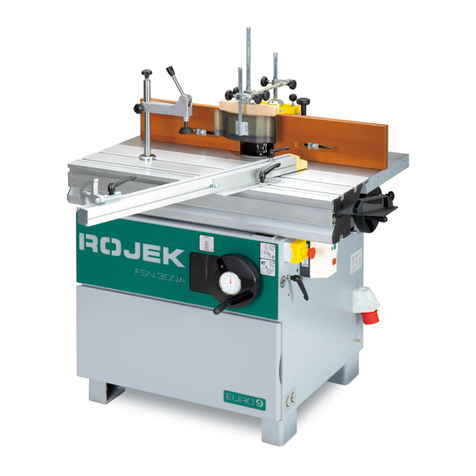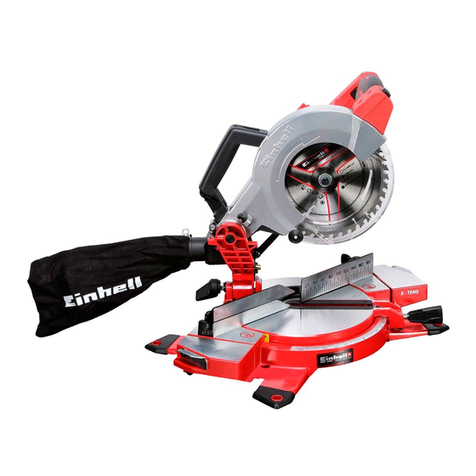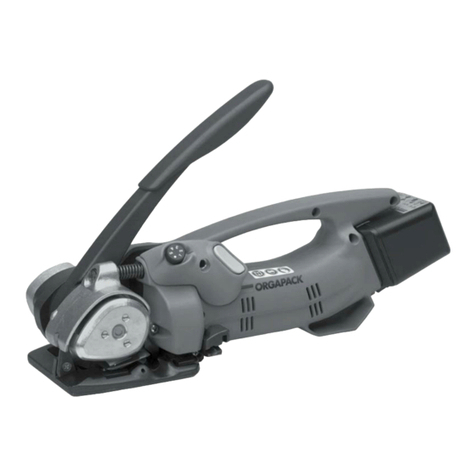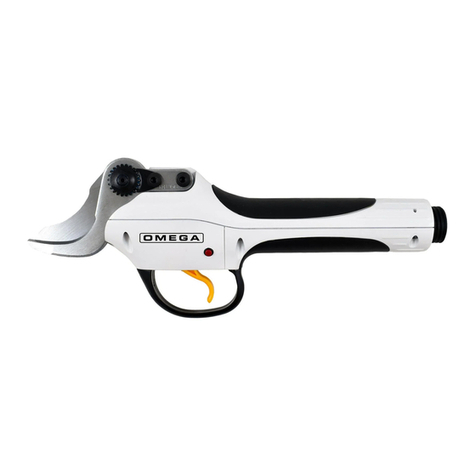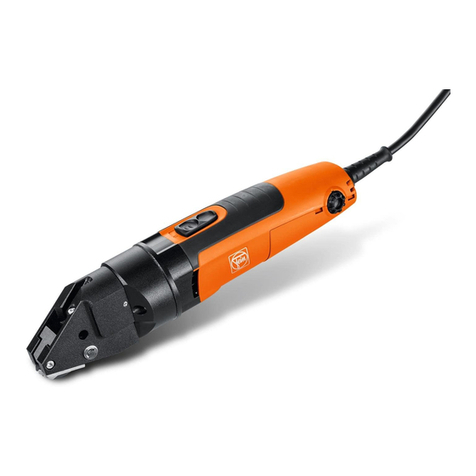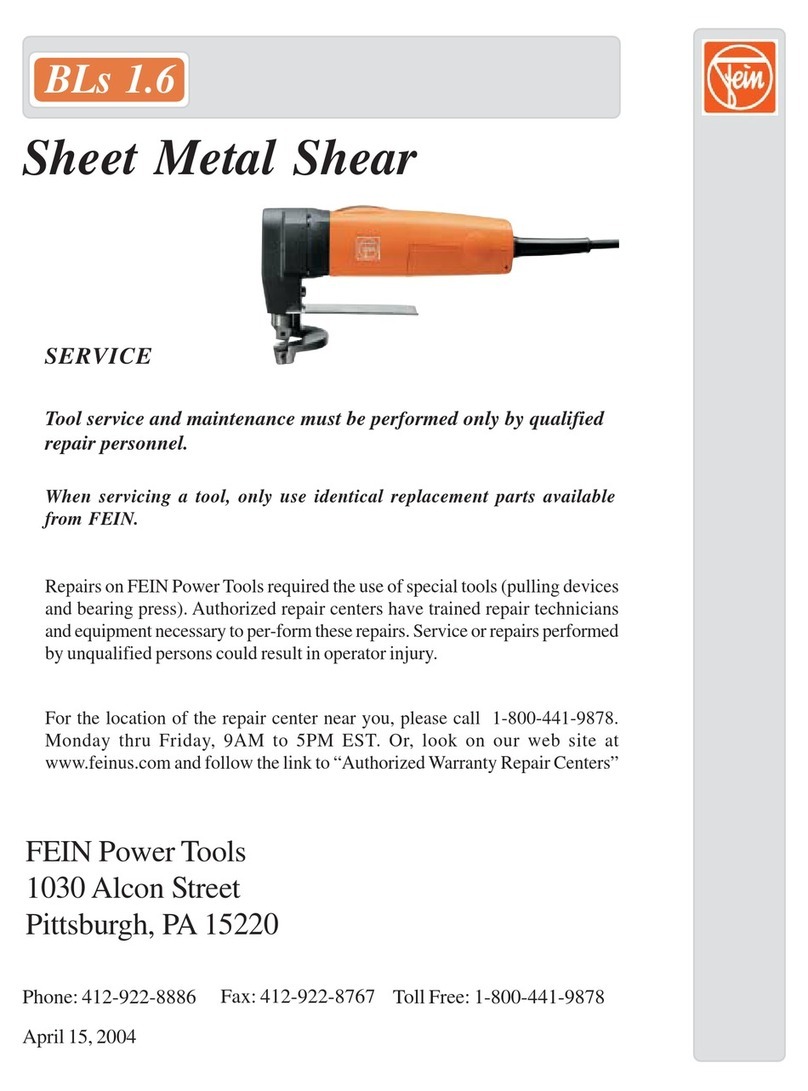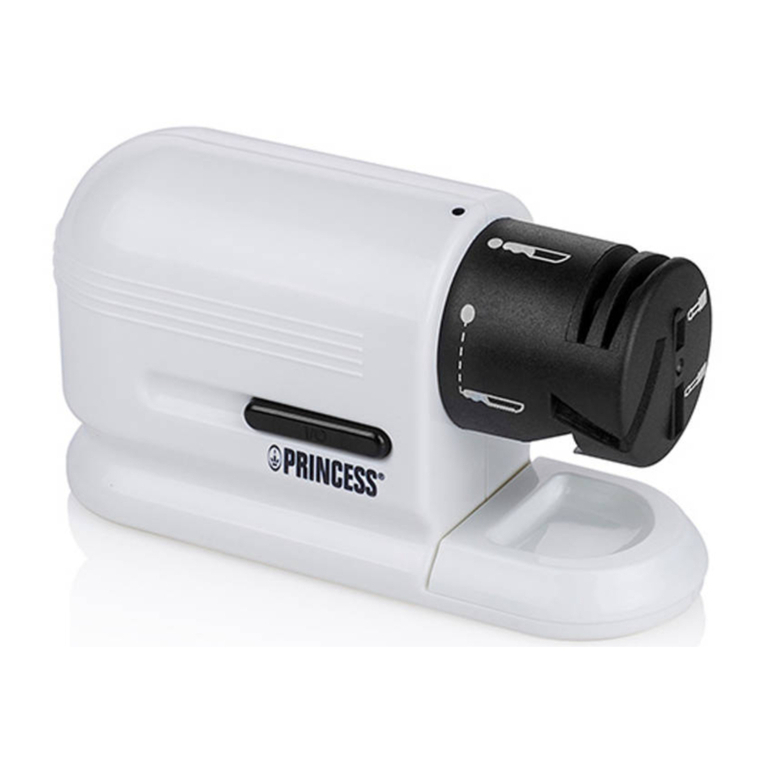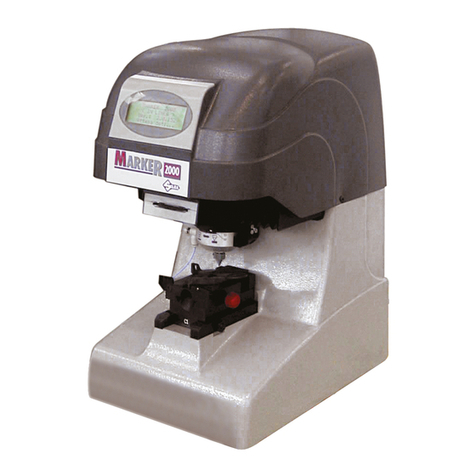
SAFETY INSTRUCTIONS
EYE PROTECTION which conforms to ANSI specifications and provides protection against flying particles both from the FRONT and
SIDE should ALWAYS be worn by the operator and others in the work area when connecting to air supply, loading, operating or servicing
this tool. Eye protection is required to guard against flying fasteners and debris, which could cause severe eye injury.
The employer and/or user must ensure that proper eye protection is worn. Eye protection equipment must conform to the requirements
of the American National Standards Institute, ANSI Z87.1, CAN/CSA Z94.4 and provide both frontal and side protection. NOTE: Non-side
shielded spectacles and face shields alone do not provide adequate protection.
Always disconnect air supply: 1.) Before making adjustments; 2.) When servicing the tool; 3.) When clearing a jam; 4.) When tool is not in
use; 5.) When moving to a different work area, as accidental actuation may occur, possibly causing injury.
Do not use gasoline or similar highly flammable liquids to clean the nailer. Vapor in the nailer could be ignited by a spark causing the tool
to explode.
When working on air tools, note the warnings and cautions in this guide and in the Operation and Maintenance Manual covering the
specific tool. USE EXTRA CARE WHEN EVALUATING PROBLEM TOOLS.
OPERATION AND MAINTENANCE MANUALS ARE AVAILABLE FREE OF CHARGE FROMBOSTITCH
1-800-556-6696 OR WWW.BOSTITCH.COM
ALWAYS DISCONNECTTOOL FROM AIR SUPPLY, REMOVE ALL NAILS ANDWEAR PROPER EYE PROTECTION BEFORE REBUILDING
ORTESTINGTOOL!
Please refer to pages 4 for figures mentioned below.
Second Handle Assembly
1. Remove three nose cap screws, See Figure 2.
2. Place the Nose Bracket (1) on the nose, and secure with the three cap screws removed in step 2. See Figure 3. Secure screws with serviceable thread
lock (Blue Loctite).
3. On the opposite side of the loading door, attach the Valve Bracket (2) to the Nose Bracket (1) using two M8x16 Cap Screws (4). See Figure 4. Note: Assembly is
reversible if desired, but will require a longer 3/8” tube (8).
4. On the side of the loading door, attach the Handle Bracket (3) to the Nose Bracket (1) using two M8x16 Cap Screws (4). See Figure 5.
5. Using 5/32”Tube (7), connect the two points labeled A together, and then connect the points labeled B together. See Figure 6.
6. Assemble 3/8” tube fitting (5) and 3/8” elbow (6) together and screw into air inlet of the N100C end cap. See Figure 7. Seal male threads with plumbers tape
or similar (not supplied).
7. Using 3/8”Tube (8), connect the valve to the tool as illustrated in Figure 7.
8. Test tool for proper operation: Connect air hose to the pipe nipple with appropriate fittings (See label C in Figure 7)
The tool should NOT actuate under the following conditions:
• Thetoolisrstpluggedintopressurizedair.
• Airconnectedandthetriggerispulled.
• Airconnectedandthehandleispulled.
• Airconnectedandboththehandleandthetriggerarepulled.
• Airconnectedandthetriggerispulledwiththecontactarmdepressedagainstaworkpiece(handlenotpulled)
• Airdisconnected,triggerpulledandcontactarmdepressedagainstaworkpieceinanysequence.
The tool SHOULD actuate under the following conditions:
• Airconnected,handlepulled,triggerpulledandcontactarmdepressedagainstaworkpiece,inanysequence.
SIEMPRE DESCONECTE LA HERRAMIENTA DEL SUMINISTRO DE AIRE, RETIRETODOS LOS CLAVOSY USE PROTECCIÓN OCULAR ADECUADAANTES
DE RECONSTRUCCIÓN O ENSAYOS DE HERRAMIENTAS!
En las páginas 4 encontrará las figuras mencionadas abajo.
Ensamble del segundo mango
1. Extraigatrestornillosconcabezadelapunta,vealaFigura2.
2. Coloqueelsoportedelapunta(1)enlapuntayasegúreloconlostrestornillosconcabezaqueextrajoenelpaso2.MirelaFigura3.Asegurelostornillosconjadorde
roscasaptoparamantenimiento(Loctiteazul)
3. Enelladoopuestodelapuertadecarga,conecteelsoportedelaválvula(2)alsoportedelapunta(1)utilizandodostornillosconcabezaM8x16(4).MirelaFigura4.
Nota:Elconjuntoesreversiblesiasílodesea,peronecesitaráuntubo9,5mm(3/8pulg.)máslargo(8).
4. Enelladodelapuertadecarga,conecteelsoportedelmango(3)alsoportedelapunta(1)utilizandodostornillosconcabezaM8x16(4).VeaFigura5.
5. Utilizandountubode3.9mm(5/32pulg.)(7),conectelosdospuntosetiquetadoscomoA,yluegolosdospuntosetiquetadoscomoB.VealaFigura6.
6. Ensambleelaccesoriodeltubode9.5mm(3/8pulg.)(5)yelcodode9.5mm(3/8pulg.)(6)enconjuntoyatornilleenlaentradadeairedeltapóndeextremoN100C.
VealaFigura7.Sellelastuercasmachoconcintadeplomeríaosimilar(nosuministrado).
7. Utilizandountubode9.5mm(3/8pulg.)(8),conectelaválvulaalaherramientacomoseilustraenlaFigura7.
8. Pruebadelaherramientaparaunfuncionamientocorrecto:Conectelamangueradeairealaboquilladelatuberíaconlosaccesoriosadecuados
(Vea la etiqueta C en la Figura 7)
LaherramientaNOdebeaccionarsebajolassiguientescondiciones:
• Laherramientaseconectaprimeroaairepresurizado.
• Elaireestáconectadoysetiradelgatillo.
• Elaireestáconectadoysetiradelmango.
• Elaireestáconectadoysetiradelgatilloydelmango.
• Elaireestáconectadoysetiradelgatilloconelbrazodecontactoreducidocontraunapiezadetrabajo(nosetiradelmango)
• Elaireestádesconectado,setiradelgatilloyelbrazodecontactoestáreducidocontralapiezadetrabajoencualquiersecuencia.
LaherramientaDEBEaccionarsebajolassiguientescondiciones:
• Elaireestáconectado,setiradelgatilloydelmangoyelbrazodecontactoestáreducidocontralapiezadetrabajoencualquiersecuencia.
TOUJOURS DÉCONNECTER L’OUTIL DU RÉSEAU D’AIR, SORTIRTOUS LES CLOUS ET SE PROTÉGER CORRECTEMENT LESYEUX AVANT DE PROCÉDER
AU RECONDITIONNEMENT OU À L’ESSAI DE L’OUTIL !
Veuillez vous reporter aux pages 4 pour les figures mentionnées ci-dessous.
Assemblage de la poignée auxiliaire
1. Retirerlesvisducapuchondunez.Voirl'illustration2.
2. Installerlaferruredunez(1)surlenezetsécuriseraveclestroisvisdecapuchonretiréesàl'étape2.Voirl'illustration3.Immobiliserlesvisavecunecollefrein(Loctitebleu).
3. Del'autrecôtédelaportedechargement,installerlaferruredesoupape(2)àlaferruredunez(1)àl'aidedesvisdecapuchonM8x16(4).Voirl'illustration4.Remarque:
L'assemblagepeutêtreinverséaubesoin,maisuntubepluslongde9,5mm(3/8po)seranécessaire(8).
4. Surlecôtédelaportedechargement,installerlaferruredepoignée(3)àlaferruredenez(1)àl'aidedesvisdecapuchonM8x16(4).Voirl'illustration5.
5. Avecuntubede3,9mm(5/32po)(7),raccordéslesdeuxpointsétiquetésAensemblepuisraccordéslespointsétiquetésBensemble.Voirl'illustration6.
6. Installerl'adaptateurdetubede9,5mm(3/8po)(5)etlecoudede9,5mm(3/8po)(6)ensembleetvissersurl'entréed'airducapuchond'extrémitéN100C.
Voirl'illustration7.Scellerlesletsmâlesavecdurubanàplomberieousemblable(nonfourni).
7. Avecletubede9,5mm(3/8po)(8),raccorderlasoupapeàl'outilcommemontréàl'illustration7.
8. Fairel'essaidel'outilpourvérierlebonfonctionnement:Raccorderleboyaud'airaumamelondetuyauaveclesadaptateursadéquats(VoirétiquetteCàl'illustration7).
L'outilnedoitPASfonctionnerlorsdesconditionssuivantes:
• L'outilestd'abordraccordéàdel'airpressurisé.
• Leraccordd'airestfaitetlagâchetteesttirée.
• Leraccordd'airestfaitetlapoignéeesttirée.
• Leraccordd'airestfaitetlesdeuxpoignéesetlagâchettesonttirées.
• Leraccordd'airestfaitetlagâchetteesttiréeetquelebrasdecontactestappuyécontrelapiècedetravail(poignéenontirée)
• Leraccordd'airestdéconnecté,lagâchetteesttiréeetlebrasdecontactestappuyécontrelapiècedetravailsoustouteslesséquences.
L'outilDOITfonctionnerlorsdesconditionssuivantes:
• Leraccordd'airestfait,lapoignéeesttirée,lagâchetteesttiréeetlebrasdecontactestappuyécontrelapiècedetravailsoustouteslesséquences.
INSTRUCCIONES DE SEGURIDAD
Cuando el equipo está conectado al suministro de aire, tanto el operador como todas las personas que se encuentren en el área de
trabajo, SIEMPRE deben usar PROTECCIÓN OCULAR que cumpla las especificaciones ANSI para resguardo contra partículas volantes
arrojadas desde el FRENTE o los LATERALES. Dicha protección ocular se requiere para proteger contra residuos y remaches volantes,
que podrían causar graves lesiones en los ojos.
El empleador y/o el usuario deben asegurar que se protejan debidamente los ojos. El equipo de protección ocular debe estar en
conformidad con los requisitos del Instituto Nacional Americano de Normas (American National Standards Institute), ANSI Z87.1, CAN/
CSA Z94.4 y proteger por delante y por el costado. NOTA: Los anteojos o máscaras sin protección lateral por sí solos no dan una
protección adecuada.
Siempre desconecte el suministro de aire: 1.) Antes de hacer ajustes; 2.) Al dar servicio a la herramienta; 3.) Al eliminar un atasco; 4.)
Cuando no esté en uso la herramienta; 5.) Al trasladarse a un área de trabajo diferente, porque puede activarse la unidad casualmente,
causando posibles lesiones.
No use gasolina ni líquidos similares altamente inflamables para limpiar la clavadora. El vapor dentro de la clavadora podría inflamarse
con una chispa ocasionando que explote la herramienta.
Al trabajar con herramientas neumáticas, observe las advertencias y precauciones de esta guía y en el Manual de operación y
mantenimiento que cubre la herramienta específica. TENGA SUMO CUIDADO AL EVALUAR HERRAMIENTAS CON PROBLEMAS.
SE OFRECEN MANUALES DE OPERACIÓN Y MANTENIMIENTO SIN CARGO DE BOSTITCH
1-800-556-6696 O WWW.BOSTITCH.COM
CONSIGNES DE SÉCURITÉ
UNE PROTECTION DES YEUX, conforme aux normes ANSI et fournissant une protection contre les projectiles en provenance de
l’AVANT et des CÔTÉS, doit toujours être portée par l’opérateur et les personnes présentes dans la zone de travail, lors du raccordement
au réseau d’air, du chargement, du fonctionnement et de la maintenance de l’outil. Une telle protection est indispensable pour vous
protéger contre les projections d’attaches et de particules qui peuvent entraîner des blessures graves.
L’employeur et/ou l’utilisateur doivent s’assurer qu’une protection des yeux est portée. L’équipement de protection doit être conforme
à la norme ANSI Z87.1, CAN/CSA Z94.4 et doit fournir une protection frontale et latérale. REMARQUE : Des lunettes sans protection
latérale et des masques faciaux ne fournissent pas la protection nécessaire.
Veillez à toujours déconnecter l’alimentation d’air : 1.) Avant d’effectuer tout réglage; 2.) Lors de la maintenance de l’outil; 3.) Au moment
de déloger une obstruction; 4.) Lorsque l’outil n’est pas utilisé; 5.) Lors du transport de l’outil dans une autre zone de travail — une mise
en marche accidentelle pourrait occasionner des blessures.
Ne pas utiliser d’essence ni d’autres liquides très inflammables pour nettoyer le marteau cloueur. Des vapeurs dans l’outil pourraient être
allumées par une étincelle et provoquer l’explosion de l’outil.
Au moment de travailler sur des outils pneumatiques, respecter les mises en garde et avertissements du présent guide et du manuel
d’entretien portant sur l’outil en question.
FAIRE PREUVE D’UNE EXTRÊME PRUDENCE DURANT L’EXAMEN D’OUTILS À PROBLÈMES.
LES MANUELS D’UTILISATION ET D’ENTRETIEN PEUVENT ÊTRE OBTENUS GRATUITEMENT AUPRÈS DE BOSTITCH
1-800-556-6696 OU WWW.BOSTITCH.COM
- 2 - - 3 -
INSTALLATION INSTRUCTIONS / INSTRUCCIONES DE INSTALACIÓN / NOTICE D’INSTALLATION
